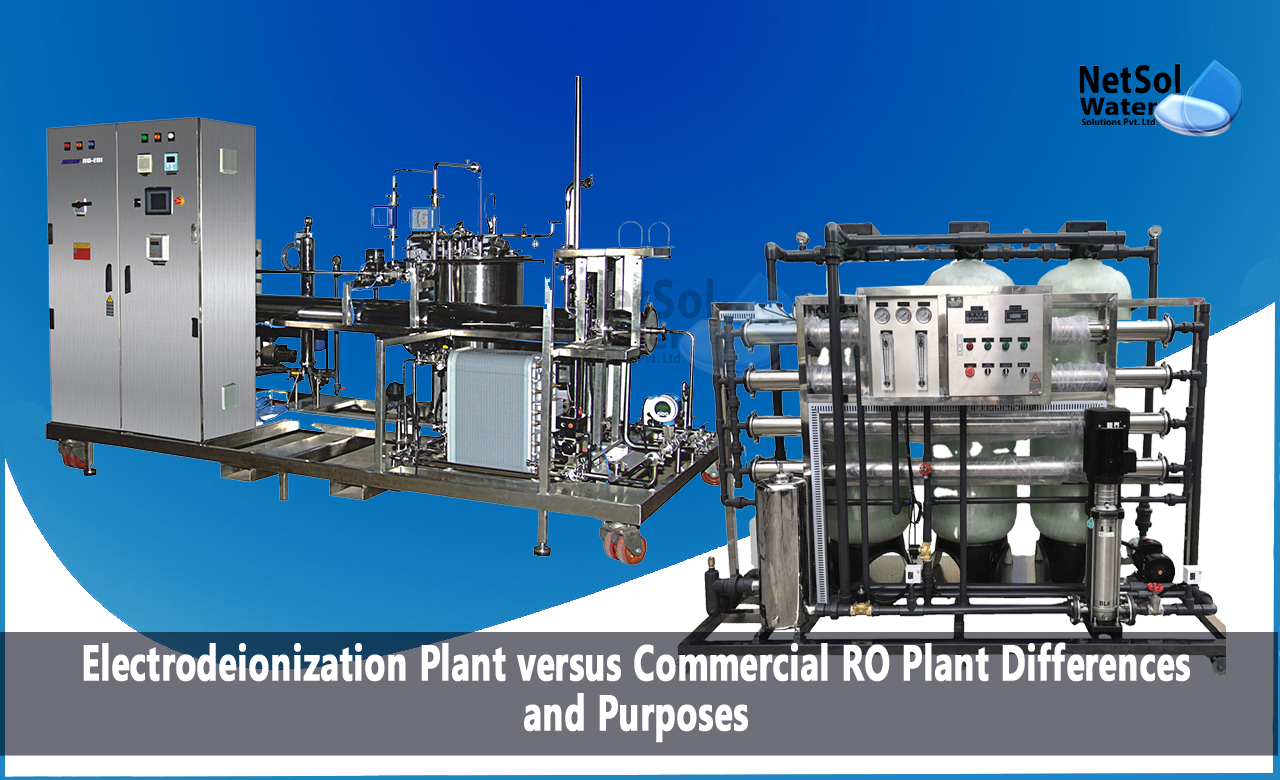The most common way to purify water uses reverse osmosis as part of the treatment process. However, some applications such as those in medicine, demand even greater levels of purity. In the majority of cases, electrodeionization devices can produce more ultrapure, chemical-free water.
Electrodeionization (EDI) and reverse osmosis (RO) are complementary but quite different processes. In this blog, the applications of reverse osmosis (RO) and electrodeionization (EDI) systems are contrasted here. The purpose of both Commercial RO plants as well as EDI systems is also mentioned in this blog.
What is the difference between EDI (Electrodeionization) Plant and Commercial RO Plant?
Commercial RO Plants: Pressure drives the process of reverse osmosis in Commercial RO Plants. To purify water, Commercial RO systems use a semipermeable membrane and a high pressure. Ions and other particles stay on the feed side of the membrane as water passes through it. Using RO membranes, significant rejection is possible.
Electrodeionization plants: A process driven by electrical current is electrodeionization. Lower pressure water is fed through an ion exchange mixed bed resin by EDI. Across the module, a DC electrical potential eliminates charged impurities while also regenerating resin.
1: The removal of Total Dissolved Solids (TDS)
Reverse osmosis membranes commonly reject 90–98% of TDS (Total Dissolved Solids) as a chemical-free water filtration technique. This method is great for getting rid of large amounts of TDS.
The main method for removing dissolved solids in EDI is ion exchange resin, which can typically remove 99.9%+ of the feed TDS. There is a maximum amount of feed TDS that an EDI can handle, since each EDI module has a finite amount of resin. Therefore, EDI is particularly effective at eliminating low levels of TDS, but is unable to remove large concentrations of TDS.
In our advice, the best method for producing high purity water is to first use Commercial RO Plant for primary TDS removal, before polishing the RO permeate with EDI.
2: Needs for space and maintenance
Comparatively speaking, EDI systems take up far less room than chemically regenerated mixed beds. EDI modules offer greater flexibility and can produce more data with the same footprint. To minimise floor area or fit in a small place, RO and EDI systems might be supplied on a single skid.
Some EDI modules can be removed without impacting the output. The only difference is that you'll need to boost the amount of electricity entering the system. It is therefore simpler to create flexible maintenance schedules, without causing equipment downtime.
How are Commercial RO plants beneficial? What is the purpose of treating Commercial RO Plants?
Salts, sugars, colour, bacteria, microbes, trihalomethanes, pesticides, TDS, heavy metals, and even volatile chemical compounds, can all be removed with remarkable efficiency using Commercial RO Plants. The dissolved gases in the water, such as carbon dioxide, cannot be removed by it.
How are EDI Plants beneficial? What is the purpose of treating EDI Plants?
Ammonia, boron, silica, leftover salts, carbon dioxide, and organic pollutants are all easily removed from water using the EDI method.
How useful are both electrodeionization (EDI) plants as well as Commercial RO Plants together?
Most plants choose RO-EDI as their method of chemical-free water treatment. Hardness, TDS, and other pollutants can typically be removed by a reverse osmosis system, to a level of 5 to 10 microsiemens. The treatment of 5–10 microsiemens and production of 0.058–0.1 microsiemens/cm by EDI are both extremely effective.
Engineers need to have an extensive knowledge of both RO Plants & EDI systems, in order to keep the size of the right RO membranes as well as EDI module stacks, and the design for the right feed pressure, and install the right instruments, as well as set up the right controls to ensure dependable operation, by using certain feed water at a particular temperature.
Conclusion
The correct water treatment plant must be selected in order to maintain this advancement, because it is crucial to every industry. You must be aware of your needs in order to complete this.
Netsol Water creates water treatment systems with the highest level of purity, and aids in maximising operational effectiveness. We work hard to keep the cost per litre of your water purification equipment as low as possible.
High quality RO + EDI systems from Netsol
Clean water is produced by Netsol Water water treatment systems, which are designed, built, and installed with safety and the environment in mind. Our various water treatment plants can be constructed according to the needs of the customer.
We also encourage our clients to talk to us about the high-quality, pure water they need. Call us at +91 9650608473 or email at enquiry@netsolwater.com for further information.



